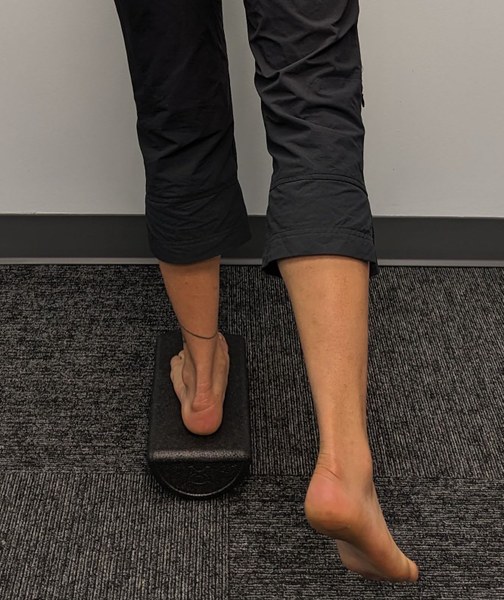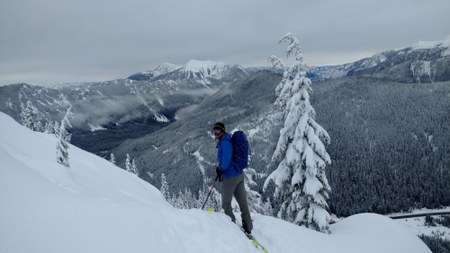
I was at the airport, ready to board a plane for my much anticipated trip to Europe. My plan was to summit Mont Blanc and, if possible, do some rock climbing. I'd spent hours refreshing the hut reservation website to secure a spot, so the anticipation was sky-high. I dream of climbing all Seven Summits one day, and Mont Blanc seemed like the perfect starting point.
That day at the airport, I was in the best climbing shape of my life. For the past six months, I'd climbed consistently at least three times a week and stuck to a training program. The upcoming climbing season had me on cloud nine. But then, it struck…
At the airport, I suddenly experienced foot pain so intense it forced me to take off my shoes as soon as I found a place to sit. I saw a noticeable bump on the left side of my foot. Compared to my right foot, the deformity was evident. I quickly started researching and sending pictures to some professional acquaintances. All signs pointed to one diagnosis: Hallux Valgus, commonly known as a bunion.
Internet searches only fueled my anxiety, with many sources saying a cure is not available. I tried to remain optimistic. I bought bigger shoes to accommodate the bunion and managed to climb Mont Blanc. The journey left me with beautiful memories, a sore foot, and several large blisters.
Once home, the pain was so debilitating that climbing became impossible. After a month-long break, my impatience grew. I traded my aggressive rock climbing shoes for flat ones that were two sizes larger. My return to the rock climbing gym was underwhelming. The pain persisted, and my performance suffered due to discomfort and the ill-fitting shoes. My hours of training felt like they'd gone to waste as I performed worse than when I'd begun climbing. On a trip to Squamish, I attempted some cracks and quickly realized that jamming is a bunion's worst enemy. Another lesson learned the hard way.
I consulted a surgeon and after undergoing intensive treatments, multiple scans, and MRI studies, the diagnosis was clear: a bunion with some fluid accumulation in the forefoot, likely indicative of bursitis. The treatment regimen was to endure the pain, wear larger shoes, and return in a year to assess the deformity's progression.
As if this diagnosis wasn't disheartening enough, a few weeks later I experienced a significant alpine fall. My foot slipped inside my shoe, causing a loss of traction and shaking my confidence in leading. I couldn't help but wonder why my body was betraying me. Would I have to abandon all the goals I had set? Before succumbing to despair, I decided to be proactive. I planned a conversation with my PT, a fellow climber, who I trusted the most.
 Kiana traversing the Leuthold Couloir on Mt. Hood during a Mountaineers trip in March, 2023. Photo by Jerry Logan.
Kiana traversing the Leuthold Couloir on Mt. Hood during a Mountaineers trip in March, 2023. Photo by Jerry Logan.
Getting to the bottom (or toe) of the bunion biz
What are bunions?
Bunions are bony bumps at the base of the big toe near the joint. They're typically painful, stiff, and swollen. They relate to a “hallux valgus” deformity where the big toe drifts outward. This creates an abnormal orientation at the big toe joint, increasing stress on the tissues and causing a bump to form.
What causes bunions?
Bunions can be hereditary and improper footwear can also be a significant contributor. Wearing shoes that are too narrow or pointy can cause repetitive stress to the big toe joint. Over time, this can change the joint's orientation and irritate the involved tissues, leading to a bunion. Too much motion or too little motion at the big toe joint could contribute to the formation of a bunion. Osteoarthritis is another potential risk factor related to bunions.
Speaking of footwear, climbers and skiers often wear arguably the worst possible shoes. What's your advice for climbers and skiers, considering that footwear size and shape directly impact performance in these sports?
There is a trade-off between comfort and performance when it comes to climbing footwear. For high-level climbers who typically wear more aggressive climbing shoes, I recommend removing shoes when not actively climbing. For instance, take them off while belaying. This provides an opportunity to realign the big toe. The key is to minimize the time spent in those shoes. Some climbers modify their shoes for better foot accommodation. However, this may compromise shoe rigidity and performance. I usually recommend that if you're not actively climbing on the wall, you should get your feet out of your shoes as much as possible to reduce stress on the big toe joint. (Try belay station exercises, Exercise 3 from the list). On non-climbing days, focus on exercises that maximize joint and soft tissue mobility in the feet, and foot/ankle stability.
As for skiing, the boot will generally better accommodate your foot, especially touring boots, which are more designed for comfort since you wear them all day and walk/hike in them more. However, after a long day of skiing, it's important to perform exercises for the foot and big toe, especially if it feels stiff or uncomfortable. Placing orthotic inserts in your ski boots aimed at supporting the arch and big toe may be helpful, but the evidence varies on their effectiveness.
What are the side effects of bunions?
Besides pain, stiffness, swelling, and a visible deformity that can cause unease, the big toe plays a significant role in proprioception, or our sense of movement and position. Our ability to balance on one foot largely depends on proprioception. If our big toe joint is painful or stiff, it can affect our balance. With climbing, the ability to balance on one foot is crucial, especially on slabby routes or when using tiny footholds. Bunions can impair performance on these routes as well as the ability to front-point in crampons or even travel uphill on steep terrain during an approach to an alpine climb.
Some activities, like front pointing in ice climbing, jamming the foot into cracks, or skiing downhill for long hours intensify the pain.
How can we mitigate this? Are there any specific precautions we can take?
Preparing the foot for these activities is crucial. Start with a proper warm-up, especially if you will be performing a lot of these activities. Taping techniques may offer some support to the big toe joint during these activities as well. (See taping techniques at the end of the article). Post-activity, consider pain relief strategies. For instance, icing can reduce pain after aggravating the foot. Self-massaging the foot can be relieving after climbing or skiing as well.
You mentioned limited mobility. What exercises can help with toe mobility?
Self-mobilization techniques can improve the big toe joint’s range of motion. Ensuring that the soft tissues of the foot, like the plantar fascia, remain flexible is crucial. Separate from toe mobility, foot and ankle stability exercises, like balancing on one foot while keeping your toes relaxed, are beneficial, as well as working on exercises to strengthen the muscles surrounding the big toe. While exercises like these are important, selecting proper footwear is vital to the health of the big toe joint.
How can we prevent bunions from worsening? Are there effective treatments, or is it true that once you have it, you are stuck with it for life?
The progression and onset of bunions might be slowed through the right choice of footwear, mobility and strength exercises for the big toe, and stability exercises for the foot and ankle. Splints and orthotic inserts may also be recommended. However, some individuals are more predisposed to bunions, and in these cases, it can be harder to prevent their formation and progression. In some cases, cutting/shaving the bone to create a neutral shape through surgery is an option, but it’s important to weigh the risks and rewards associated with any surgical procedure.
After my diagnosis and pursuing all potential treatments, the consensus was that I can't wear aggressive shoes anymore. Wearing looser ski boots means I can't ski as steeply and with as much control. These changes have been mentally challenging, especially since outdoor adventures and sports are integral to my life. What advice do you have for someone in my situation?
Understand that limitations or symptoms are not always permanent. There are typically things we can do to improve or worsen our condition, but we’re rarely in a fixed, unchangeable state. The way you feel now, climbing in larger shoes or skiing in bigger boots, won't necessarily remain the same. As time progresses, you’ll likely adjust to the new fit and become more adept. There might be a steep initial learning curve, but with time and the right combination of exercises and self-care, you can find a balance that allows for high performance and minimal pain. This could even let you entertain the idea of occasionally wearing more aggressive climbing shoes for significant objectives if you are able to manage your symptoms effectively.
Injuries that impact us mentally and emotionally require more than just physical attention. It’s important to establish a team of trusted medical providers to lean on for support.
I recommend tapping into the mental health community and taking advantage of telemedicine. Find a licensed professional with whom you can share your feelings, fears, and frustrations, preferably someone experienced with injured athletes. Keep in mind, it is better to have a support system lined up in advance, rather than scrambling to find one after an injury occurs. Preparing for potential setbacks and knowing who's on your team can make a world of difference.
Exercises to try at home
1. Plantar fascia mobilization with trigger point release ball. Roll a ball under your foot for 60 seconds to self-massage the plantar fascia. This will reduce pain, tenderness, and tightness.
2. Single leg balance on unstable surface. Stand on one leg on an unstable surface (such as an inverted half round foam roll) for 30-60 seconds (2-3 sets) to improve foot and ankle stability.
3. Strict plane toe-offs. Using friction from the floor, align the big toe to point straight ahead and go up onto your toes (10 repetitions, 3 sets). This is a great exercise to try while at the belay station.
Taping Techniques
1. Pre-cut the kinesiology tape strip.
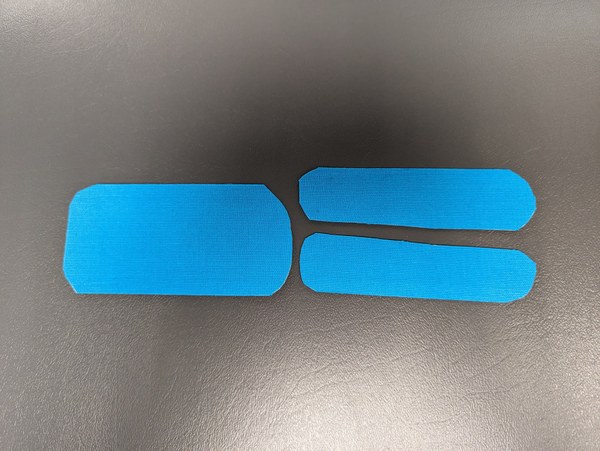
2. Stretch and wrap the first narrow strip around the big toe.
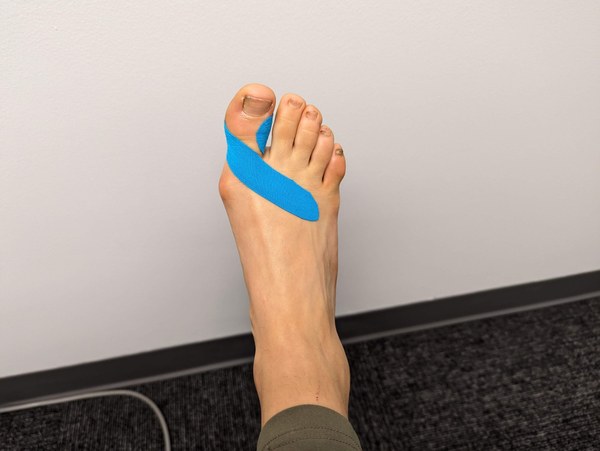
3. Apply the second strip in a similar way, slightly offset with the first strip.
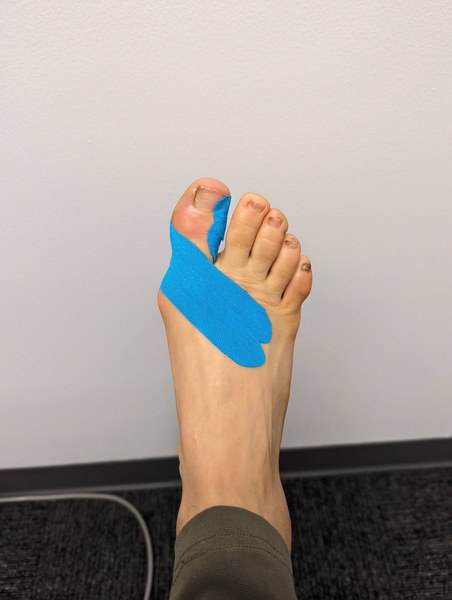
4. Wrap the wide strip around the foot, covering the narrow strips.

For anyone out there grappling with the challenges of bunions like me, you are not alone. About one in four people share this journey with you. While it's undeniably a hurdle, it's not an insurmountable one. Every mountain has its difficult paths, but the view from the top is always worth the climb. Stay resilient; not every climb is vertical. Sometimes, our greatest challenges come in unexpected forms.
Grant Hennington, DPT is a Seattle-based physical therapist and clinic manager at Salmon Bay Physical Therapy. His clinical interests include rehabilitation and training of runners, climbers, skiers, and cyclists. He is passionate about helping others achieve their rehab goals through a combination of exercise and manual therapy.
This article originally appeared in our winter 2024 issue of Mountaineer magazine. To view the original article in magazine form and read more stories from our publication, visit our magazine archive.
 Kiana Ehsani
Kiana Ehsani

